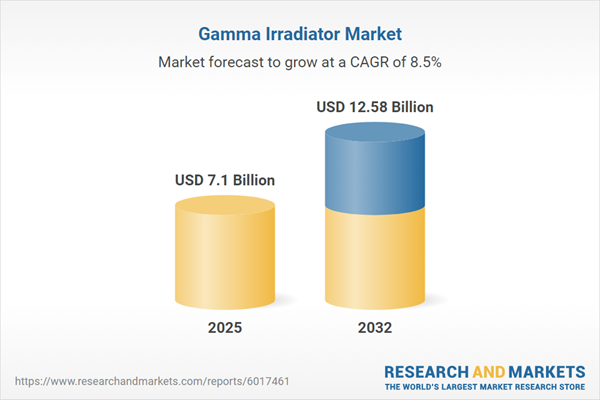Speak directly to the analyst to clarify any post sales queries you may have.
The gamma irradiator market is rapidly advancing as industries worldwide seek robust, compliant, and sustainable solutions for sterilization and preservation. Decision-makers are prioritizing technologies that unlock safer operational processes and ensure regulatory adherence for diverse applications.
Gamma Irradiator Market Snapshot
The Gamma Irradiator Market grew from USD 6.53 billion in 2024 to USD 7.10 billion in 2025. It is expected to continue growing at a CAGR of 8.54%, reaching USD 12.58 billion by 2032. This sustained expansion is being shaped by factors such as rising standards in product safety, global supply chain optimization, and evolving requirements in sterilization and preservation for essential sectors.
Scope & Segmentation of the Gamma Irradiator Market
This report offers detailed segmentation and comprehensive insight across the entire value chain of gamma irradiation technologies.
- Product Types: Blood irradiation systems, food irradiation systems, insect control systems, and sterilization units.
- Applications: Agricultural commodities, food preservation, insect control, medical device sterilization for hospitals, pharmaceutical manufacturers, and pharmaceutical processing for both manufacturers and research institutions.
- Source Activity Levels: High activity, medium activity, and low activity gamma sources.
- Geographic Regions:
- Americas: United States, Canada, Mexico, Brazil, Argentina, Chile, Colombia, Peru
- Europe, Middle East & Africa: United Kingdom, Germany, France, Russia, Italy, Spain, Netherlands, Sweden, Poland, Switzerland, United Arab Emirates, Saudi Arabia, Qatar, Turkey, Israel, South Africa, Nigeria, Egypt, Kenya
- Asia-Pacific: China, India, Japan, Australia, South Korea, Indonesia, Thailand, Malaysia, Singapore, Taiwan
- Key Companies: Sterigenics International LLC, Nordion (Canada) Inc., Best Theratronics Ltd., Iotron Industries Inc., Ionisos Process SA, Shinva Medical Instrument Co. Ltd., China Isotope & Radiation Corporation, Synergy Health Limited.
Key Takeaways for Senior Decision-Makers
- Gamma irradiators have become essential for industries requiring rigorous sterilization, supported by the technology’s capacity for deep penetration and uniform dose control.
- Healthcare and food sectors lead adoption, with increasing relevance in sustainable agriculture and pharmaceutical manufacturing.
- Evolving regulatory frameworks and international trade harmonization demand continued investment in digital validation and traceability capabilities.
- Technological advances such as automation, remote monitoring, and integration of IoT features are reshaping operational efficiency and compliance.
- Segment-specific approaches allow operators to address unique application and regional challenges, maximizing material compatibility and supply resilience.
- Competitive differentiation is increasingly built on innovation partnerships, expanded service offerings, and robust customer engagement strategies.
Tariff Impact and Strategic Adaptation
The introduction of new United States tariff measures in 2025 has influenced supply chain structures, procurement, and domestic production strategies across the global ecosystem. Companies are responding by diversifying supplier relationships, investing in local manufacturing capabilities, and optimizing maintenance services to mitigate import cost pressures. These actions are designed to maintain operational continuity and protect cost efficiency in the face of changing trade policies and component levies.
Methodology & Data Sources
The research utilizes in-depth executive interviews, a comprehensive review of technical publications, patent filings, regulatory documents, and site visits to irradiation facilities. Iterative validation with industry advisory panels ensures accuracy, relevance, and real-world applicability across qualitative and quantitative insights.
Why This Report Matters
- Support strategic planning with actionable insights across all tiers of the gamma irradiation market, including product, application, and regional segments.
- Equip senior leaders with an understanding of regulatory, technological, and geopolitical factors that are directly shaping capital investment and compliance strategies.
- Enable confident resource allocation by outlining scenario-driven responses to tariff environments, technology evolution, and end-use market shifts.
Conclusion
The gamma irradiator market is navigating dynamic pressures in technology, regulation, and trade. Executives equipped with this comprehensive analysis will be able to drive strategic transformation and realize sustainable competitive advantage.
Additional Product Information:
- Purchase of this report includes 1 year online access with quarterly updates.
- This report can be updated on request. Please contact our Customer Experience team using the Ask a Question widget on our website.
Table of Contents
3. Executive Summary
4. Market Overview
7. Cumulative Impact of Artificial Intelligence 2025
Companies Mentioned
The companies profiled in this Gamma Irradiator market report include:- Sterigenics International, LLC
- Nordion (Canada) Inc.
- Best Theratronics Ltd.
- Iotron Industries Inc.
- Ionisos Process SA
- Shinva Medical Instrument Co., Ltd.
- China Isotope & Radiation Corporation
- Synergy Health Limited
Table Information
| Report Attribute | Details |
|---|---|
| No. of Pages | 190 |
| Published | October 2025 |
| Forecast Period | 2025 - 2032 |
| Estimated Market Value ( USD | $ 7.1 Billion |
| Forecasted Market Value ( USD | $ 12.58 Billion |
| Compound Annual Growth Rate | 8.5% |
| Regions Covered | Global |
| No. of Companies Mentioned | 9 |









